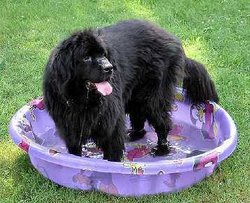
|
From Wikipedia the free encyclopedia, by MultiMedia |
| Newfoundland | ||
|---|---|---|

Newfoundlands are known for their love of water and
their
drool.
|
||
| Alternative names | ||
| Country of origin | ||
| Newfoundland, (now part of Canada) | ||
| Common nicknames | ||
| Newfie | ||
| Classification and breed standards | ||
| FCI: | Group 2 Section 2 #50 | |
| AKC: | Working | |
| ANKC: | Group 6 (Utility) | |
| CKC: | Group 3 - Working Dogs | |
| KC (UK): | Working | |
| NZKC: | Utility | |
| UKC: | Guardian Dogs | |
| Not recognized by any major kennel club | ||
| This breed of Dog is extinct | ||
| Notes | ||
The Newfoundland is a large, usually black, breed of Dog originally used as a working Dog in Newfoundland, Canada. They are known for their sweet dispositions. They are very loyal to their families and possess natural water rescue tendencies.
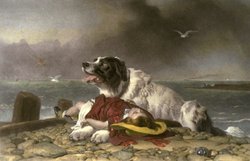 A
Landseer painting of a Landseer Newfoundland.
A
Landseer painting of a Landseer Newfoundland.
Newfoundlands ("Newfies") have webbed feet and a water-resistant coat. Males weigh 60–70 kg (130–150 lbs), and females 45–55 kg (100–120 lbs), placing them in the "giant" weight range.
Most Newfies are black, but brown, gray (very rare), Irish Spotted (black with white markings), and Landseer (black head, white body with black markings) varieties exist. The Landseer is named after the artist Sir Edwin Landseer, who featured them in many of his paintings. Some kennel clubs consider the Landseer to be a separate breed; others consider it simply a Newfoundland color variation. Some kennel clubs consider Irish Spotted to be an "invalid" marking, and these clubs will not allow them to be shown.
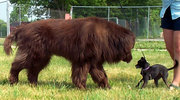 A brown Newfie investigates a
Chihuahua-sized
mixed-breed Dog.
A brown Newfie investigates a
Chihuahua-sized
mixed-breed Dog.
Newfies have a gentle, placid disposition. They are nicknamed the "Gentle Giant" and "Nature's babysitter." Indeed, the official AKC breed description says "Sweetness of temperament is the hallmark of the Newfoundland; this is the most important single characteristic of the breed." They are protective of children. The Dog Nana in James M. Barrie's Peter Pan was a Newfoundland. (Newfie owners resent the depiction of her as a St. Bernard in the Disney animated film version; the 2004 film Finding Neverland used a Great Pyrenees).
The Newfoundland is smart and loyal. The breed is easily trained as they are eager to please their masters. They are not easily frightened nor excitable. Relative to other breeds, Newfoundland puppies, especially older puppies, tend to be calm. Puppyhood doesn't last for extended amounts of time as in some breeds. They get along wonderfully with other Dogs. They have deep, fierce-sounding barks, but are not good guard Dogs. They have been known to grieve when separated from their families. Despite their wonderful qualities, this breed is not for everyone. Their large size makes them difficult to keep in many living situations, although they do not require great amounts of exercise and as puppies they tend to tire easily.
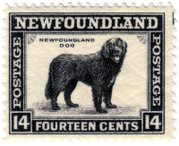 Newfoundland Dog Stamp
Newfoundland Dog Stamp
The origin of the breed is uncertain, but they were in use as working Dogs on the island of Newfoundland as early as AD 1000. It is said that Newfoundlands were bred to pull in the fishermens' nets. Newfoundlands have been used as water rescue Dogs and for draft work. National Geographic's program "Dogs with Jobs" named the Newfoundland as the strongest draft Dog on earth. The breed almost became extinct; most modern-day Newfoundlands trace their ancestry to a single stud Dog named Siki who lived in the 1920s.
As with many large breeds, they have a tendency for hip dysplasia. A potential buyer should seek proof of hip certification from the breeder.
Capt.
Meriwether Lewis owned a Newfoundland named Seaman. The Dog was a valuable
member of the famous
Lewis and Clark Expedition.
[1]
The Newfoundland Dog shown on the 14 cents stamp is Ch. Westerland Sieger and
was owned by the Honourable Harold MacPherson.
Unofficially, the second most important breed characteristic is a tendency to drool. Newfie owners acknowledge this cheerfully, proudly displaying paraphernalia with slogans such as "Newfoundland is my name—slobber is my game" and "Spit happens." One club assures that "that's OK, because drool is good for you."[2] Some breeders offer puppies which have been bred so that their jowls are shorter. They do not hang down as far, and thus they don't drool as much as the common Newfoundland. They are the so-called "dry-mouths".
Gander, a Newfoundland Dog serving with Canadian infantry in Hong Kong in 1941 was posthumously awarded the Dickin Medal in 2000. The medal was instituted in 1943 by Maria Dickin to honour the work of animals in war and has become recognised as "the animals' Victoria Cross".
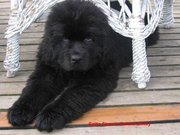 A Newfoundland puppy
A Newfoundland puppy
On February 2, 2004, a 70 kg (155 lb) Newfoundland, Champion Darbydales's All Rise Pouchcove (callname Josh), took the Westminster Kennel Club Dog Show's prize for Best in Show.
Dogs, made by MultiMedia | Free content and software
This guide is licensed under the GNU Free Documentation License. It uses material from the Wikipedia.